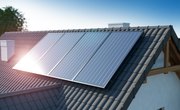Advances in solar power technology let travelers use the power of the sun instead of noisy generators. Recreational vehicle dealers sell kits to convert campers to solar power, but you can easily obtain the components to power your camper with sunlight.
Solar System Conversion
Older campers may be wired for 12-volt direct current (DC) power, the standard for automotive electrical power. If the power receptacles are circular, like an auto cigarette lighter, your system is 12-volt. Solar panels generate and batteries store DC electricity, so conversion is straightforward. More modern campers could be wired for 110-volt alternating current (AC) power: normal household current. AC power lets you use standard appliances, but requires a more complicated (and expensive) system. If you only use your camper once or twice a year, a DC system will be more cost-effective. Consider an AC system if you plan to camp more often. Think about your electrical requirements to determine how much power you'll need to collect and store. Keep efficiency in mind. A solar system can power large appliances such as microwaves and televisions, but the required gear can be expensive. By contrast, a system that powers only lighting and small appliances can be quite affordable. Regardless of the size of your system, it's wise to minimize load. Use LED or compact fluorescent lighting rather than inefficient incandescent bulbs. Consider using propane for heating and refrigeration. The storage capacities of batteries are measured in amperage-hours, while the output of solar panels and consumption of appliances are measured in watts. To convert, multiply the amperage by 12 (the voltage of the system) to determine the wattage or divide the wattage by 12 for the amperage. For example, a single 15-watt fluorescent light consumes 1.25 amps of power each hour, so a 100 amp battery could power it for 80 hours. A 85-watt solar panel generates 7 amps of power an hour and thus could fully charge the battery in just over 14 hours. Residential solar panels are too fragile for campers, so use sturdier non-glass RV solar panels. Make sure your wiring is up to the task. In particular, the wiring from the panel to the battery must be at least 10-gauge to prevent power loss. Your solar panels will feed into deep-cycle storage batteries, governed by a controller to prevent overcharging. Batteries can be combined in parallel for greater storage. Secure batteries in an accessible location, but away from open flames as batteries could generate flammable hydrogen gas. DC appliances can be connected through a fuse panel directly to your batteries. An inverter converts the DC power to the AC power 110-volt appliances need. Install a transfer switch which lets you run your camper using power from a campground or a generator when solar power isn't available. You won't be able to charge your batteries from AC power with an inverter. Use an automotive trickle charger to top off your batteries with household current.
References
Writer Bio
Based in Colorado, Erik Johnson has been writing professionally since 1996 and has worked in real estate, management and technical fields. Recipient of the 3M Richard G. Drew Recognition of Creativity, Johnson is the author of three books.



